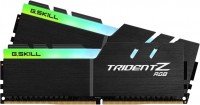RAM G.Skill series Aegis
G.Skill Aegis
The Aegis series RAM was introduced in 2020 and immediately caused a lot of controversy. Many were confused by the idea of replacing a full-fledged radiator with an essentially metal sticker. After all, we are talking about overclocking memory. However, the anger of gamers quickly turned to mercy, because at a low price, the Aegis bars showed impressive performance, quickly picked up the necessary XMP profiles and did not suffer much from heating. Memory immediately flew into the top of sales, forming the company of the popular HyperX Fury and Crucial Ballistix RAM. It is symbolic that this series was named after the magical Aegis cape, which Zeus converted into a shield during the war with the Titans.
 |
The entire Aegis model range is adequately represented in east european stores. At the bottom of the hierarchy are 4-gigabyte entry-level slats with a base frequency of 2400 MHz and a timing scheme of 15-15-15-35 or 17-17-17-39. They are followed by folk models with a volume of 8 GB, which are most often taken in pairs in game builds of medium and high level. Fortunately, by the standards of 2021, 16 GB of RAM is enough for games. In this case, the choice of frequencies is much wider: the frequency spectrum extends from 2133 to 3200 MHz, and the voltage can be either 1.2 V or 1.35 V.
Well, the "upper floors" of the line are inhabited by overclocking kits with a volume of 16, 32 and even 64 GB. They consist of the same 8 GB slats, so their frequencies and timing schemes are identical. Also in the Aegis series, an outdated DDR3 class RAM is occasionally found, which for some reason may be of interest to owners of old computers. Due to her age, she is not friends with XMP and at the same time is more expensive than more modern models of the DDR4 class.



